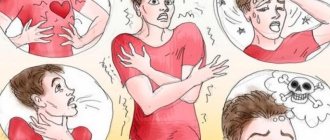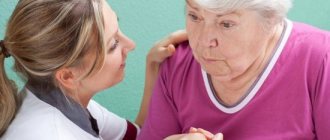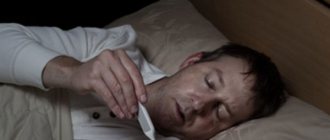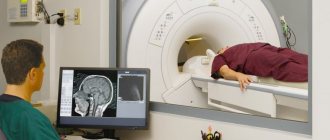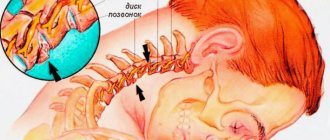Neurosis in a teenager
Neuroses are most often shallow mental disorders that arise due to the impact of various types of psychological trauma on the individual.
Currently, a fifth of the world's population suffers from neuroses. During adolescence, girls suffer from neuroses more often than boys. This affects self-esteem, attitude towards oneself and relationships with others. Family problems are often to blame for this. Some children begin to develop neurosis, others suffer from disturbances in behavior and desires.
Teenage crisis
The psychological crisis in adolescence is the most acute. It’s not called the “negative phase of puberty” for nothing. It is characterized by a decrease in academic performance, disharmony of the individual’s inner world, a change of interests, and criticism. The teenager is actively engaged in self-analysis and knowledge of his own experiences. Many people start keeping a diary.
Negativism is also a symptom of the teenage crisis: hostility appears, a tendency to violate discipline and quarrels, and a desire for loneliness. Harmony between rights and responsibilities is very painful to form. Negativism is especially pronounced in young men.
They strive for permissiveness, calling it freedom. But a directive style in relationships with a teenager is unacceptable. You need to communicate patiently and agree on rules of behavior. A teenager needs to be understood and respected as an individual, and not humiliated and “read morals.”
Relationships with peers are more important for adolescents than with adults. The teenager becomes isolated from his family. Often teenagers form groups and companies with common interests, whose values differ from those of adults, and oppose them. This gives them a sense of independence.
Causes of neuroses in adolescents
Children and adolescents suffer from neuroses due to various provoking factors. The most common reasons:
- conflicts with parents;
- unfavorable family situation (alcoholism of father/mother, living with stepmother/stepfather);
- constant irritability;
- minor brain disorders caused by difficult pregnancy and difficult childbirth;
- high demands on yourself;
- conflicts with peers;
- hypersensitivity and emotionality;
- hormonal surge;
- lack of attention.
- symptoms and signs of neurosis and adolescents
- distrust, suspicion;
- sleep disturbance;
- low self-esteem;
- fear, fear, uncertainty;
- irritation due to fatigue;
- pathological uncertainty, indecision;
- increased loads;
- excessive touchiness;
- decreased concentration.
Try asking your teachers for help
Summary for parents
Teenage neuroses are easier to prevent than to get rid of them. Treatment of neurosis until complete recovery is possible with timely seeking help from specialists and patiently following all recommendations.
Prevention of teenage neuroses largely depends on proper upbringing and family relationships. It is important to teach children to overcome life’s difficulties, to mentally strengthen a child with an anxious and suspicious character, and to be interested in his problems and interests.
State TV and Radio Company “Crimea”, program “The ABC of Health”, issue on the topic “Neuroses in Adolescents”:
Manifestation of neuroses
Nervous disorders in children and adolescents can manifest themselves in different ways. They come in the following types:
- Nervous tic. Neurosis in children and adolescents can manifest itself in the form of unconscious twitching of limbs, eyes, mouth, cheeks, shrugging of shoulders, unreasonable movements of hands, and smacking. A nervous tic that occurs when a child is absolutely calm is one of the signs of a nervous disorder. With active activity, the tic disappears.
- Poor sleep or insomnia. If a child has not previously had problems with sleep, he always got enough sleep, but suddenly he began to toss and turn frequently, sleep restlessly and wake up in the middle of the night, or even stopped falling asleep altogether, you should also pay attention to this symptom. In this form of the disorder, children also talk during sleep, and it becomes very realistic. There are also cases of sleepwalking.
- Stuttering. This form of the disorder occurs in children around the age of three, but can also occur later. During this period, the baby learns to talk. It is very important not to overload the child, as overexertion may cause him to experience stress, which will cause parents a lot of anxiety in the future. Stuttering also often occurs during prolonged separation from loved ones. If you do not pay attention to this problem in time, it will be much more difficult to cure stuttering in the future.
- Anorexia. This form of nervous disorder is expressed in a reluctance to eat food. If a child was forced to eat in childhood, then in adolescence the child will begin to strive for a slim figure, and therefore may refuse to eat at all. It is best to treat anorexia in the early stages of manifestation, as adolescents show greater independence and believe that they know better what they need.
Ask a question to the experts and get an answer within 15 minutes!
Incorrect behavior of parents under the guise of strong love and desire to help also often leads to the development of neurosis. In order to prevent the development of the disease and its appearance, you cannot only note the child’s shortcomings, constantly pointing out weaknesses, thinking that this will benefit the child. In this case, you need to concentrate on the advantages. You cannot send your child to schools, clubs and other sections that he does not like, creating an overload. Also, you should not overprotect the child. But the most important thing that must be observed so that the child does not have psychological problems is maintaining a friendly atmosphere in the family and the absence of scandals. It is necessary to give the child the opportunity to exercise independence. You should not put a ban on questions regarding puberty and love relationships.
Physically, neuroses can manifest themselves in the form of depression, insomnia, tearfulness, lack of appetite, panic attacks, and headaches.
Teens may also suffer from hyperhidrosis, which causes an increase in sweat production. The pathological process is often accompanied by tachycardia. When the disease occurs, adolescents may also experience a feeling of lightheadedness and cramps in the intestines. Hyperemia (redness of the skin) is also common.
Chapter 13. Neuroses
Features of neuroses in adolescence
The incidence of neuroses in adolescence is much lower than in childhood, and the relatively high incidence of them (about 15% of those registered in psychoneurological dispensaries) is due to those adolescents who have suffered from neuroses since childhood.
It may be surprising that the period of puberty, the “pubertal crisis,” does not lead to a sharp increase in the incidence of neuroses. Probably the fact is that at this age there is a tendency to “replace” neurotic vegetative and motor symptoms with behavioral disorders.
The same psychogenic factors that cause neurosis in children and adults, although with different patterns of manifestations, lead to deviant behavior in adolescents during the period of character development.
In adolescence, the same forms are distinguished as in adults: neurasthenia, hysterical and obsessive-phobic neuroses. In terms of the picture of neuroses, this age is undoubtedly closer to adulthood than to childhood, when one encounters still poorly differentiated forms.
The difference from adults consists in some features of psychogenic factors and psychogenesis, reflecting the specifics of adolescence (for example, the emancipation reaction), as well as in a more distinct connection of certain forms of neuroses with certain types of character accentuations.
Neurasthenia
Neurasthenia is the most common form of neurosis in adolescents. It develops more often in representatives of asthenoneurotic and labile types of character accentuation. Its main symptoms in adolescents are the same as in adults.
Increased fatigue, especially during mental stress and exciting situations, is combined with irritability, which increases with fatigue. Hence, psychological protection becomes the desire to protect oneself from physical and mental stress [Smetannikov P. G., 1981].
Sleep disturbances, headaches, low mood and a tendency to hypochondria are also observed.
Just as in adults, two types of neurasthenia can be distinguished - hypersthenic and asthenohypochondriacal.
Hypersthenic type. The leading symptom is extreme irritability, which intensifies with fatigue and in a tense environment. Outbursts of irritation arise from insignificant reasons and often end in tears and repentance. They can be addressed to both family and friends, as well as completely random strangers, both adults and peers.
Excitability also manifests itself in intolerance to noise, less often bright light and strong odors. Pronounced autonomic lability can be judged by fluctuations in pulse rate, blood pressure, and vasomotor play.
Sometimes autonomic reactions reach the level of crises reminiscent of diencephalic ones - with sharp tachycardia, profuse sweat, redness or pallor of the skin, intestinal spasms, dizziness, a feeling of lightheadedness, etc.
Usually such attacks follow severe anxiety. In girls they occur more often during menstruation.
Sleep disturbances are manifested by difficulty falling asleep, sometimes restless sleep with heavy dreams and repeated awakenings [Tupitsyn Yu. Ya., 1971]. Headache is usually of the “muscular type” [Karvasarsky B.D.
, 1980] - with a feeling of tightness, compression, soreness of the skin on the head. Headaches are worse in the morning, especially if the teenager gets up later than usual, “sleeping off the previous days” (“Sunday morning headaches”).
Complaints about difficulty concentrating during classes and worsening memory are also common.
Asthenohypochondriacal type. In these cases, increased fatigue, lethargy, and a tendency to continually seek rest and peace come to the fore. Instead of outbursts of anger, irritability manifests itself in tearfulness and lamentations.
Along with complaints of poor sleep, difficulty falling asleep, lack of freshness after sleep, lethargy and drowsiness during the day are emphasized.
Complaints about headaches are usually overshadowed by a mass of other somatic complaints - palpitations, irregularities, discomfort in the heart area, pain in the area of the heart impulse, abdominal cramps, dull and unclear pain in different parts of the body. The heart most often remains the center of hypochondriacal experiences during neurasthenia in adolescents, especially in boys.
Perhaps the reason for this is growth characteristics - a physiological lag in the increase in the size of the heart from the growth of the whole body. In girls, hypochondriacal complaints about the function of the gastrointestinal tract are no less common. As a rule, a decrease in mood is noted, but unlike endogenous and reactive depressions, the decrease in mood appears little outwardly.
Flow. Neurasthenia usually lasts a long time - months and years with periods of significant improvement until complete practical recovery and new deterioration under the influence of mental trauma and difficult stressful situations.
However, in most cases there is no steadily progressive deterioration and therefore there is no need to talk about “neurotic development”.
With proper treatment and favorable conditions, even very prolonged disorders can gradually disappear by the end of puberty.
Differential diagnosis. First of all, it is necessary to exclude chronic somatic diseases, often accompanied by a neurosis-like syndrome (chronic cholecystitis, spastic colitis, chronic pneumonia, bronchial asthma, etc.
), as well as cerebrovascular disease after traumatic brain injury and as a consequence of brain infections and intoxication. It should be kept in mind that teenagers sometimes hide traumatic brain injuries from their parents.
With cerebrovascular disease, headaches are more often of the vascular type (with a feeling of pulsation in the head), combined with dizziness, riding in transport, swings, heat and stuffiness, weather changes with sharp fluctuations in atmospheric pressure are poorly tolerated.
The criteria for differential diagnosis with asthenohypochondriacal syndrome in neurosis-like sluggish schizophrenia are described in more detail in Chap. XV. The absence of obvious psychogenic factors preceding the disease may suggest this, but their presence does not exclude their provocation of low-grade schizophrenia.
Subsequently, with the latter, an unusual pretentiousness in the description of hypochondriacal experiences, complaints about difficulties in thinking, and not only about poor memory and the inability to concentrate, as well as isolation from peers and indifference and even hostility towards loved ones gradually emerge. The differences from the hypochondriacal equivalent of depression are not always clear.
With depression, external manifestations of decreased mood are more visible and there is no pronounced vegetative lability.
prevention of alcoholism – previous | next – obsessions
Adolescent psychiatry. .
Source: https://vprosvet.ru/biblioteka/nevrozy/
Treatment and prevention of neuroses
Treatment of neurosis in children must begin as early as possible so that the symptoms do not become entrenched. The participation of parents, their help and desire to help is important.
This disease can only be treated by a specialist - a neurologist or psychotherapist, a child or family psychologist, as well as specialized specialists - an endocrinologist, a psychiatrist.
Treatment can be verbal or medication. To save a child or teenager from this disease, it is necessary to remove all resentment, anxiety and guilt, and also determine the cause of the stress that occurs.
Various methods of psychotherapy are of great importance in the treatment of neuroses, such as hypnosis (if a teenager has obsessive fears and anxiety), autogenic training, psychoanalytic therapy (helps to recognize internal conflicts and complexes).
Drug treatment is prescribed as an adjunct and only in advanced cases. However, it should be remembered that medications can either improve or worsen the situation. Often, adolescents are prescribed herbal medications, such as valerian, motherwort, and chamomile.
Timely prevention of the disease will avoid nervous disorders and long-term treatment. Parents should monitor their child's psychological health. Do not subject him to heavy stress, control his daily routine, and do not provoke stress. Prevention largely depends on family relationships and the characteristics of upbringing.
Still haven't found the answer to your question?
Just write what you need help with
Asthenic neurosis: causes, manifestations and treatment tactics
Asthenic neurosis or neurasthenia is one of the most common forms of neuroses today and accounts for about 34% of the total incidence of neuroses in children and adults.
This pathological condition occurs as a result of exhaustion of the nervous system and the appearance of its persistent imbalance.
The disease in most cases occurs as a result of prolonged physical and/or psycho-emotional stress.
In medicine, the term “asthenia” meant “weakness of the nerves.”
It was proposed by John Brown and described by George Beard back in the 18th century.
The pathology is characterized by:
- increased nervous excitability;
- high exhaustion of the nervous system in the form of increased fatigue and decreased performance;
- persistent headaches;
- sleep disorders;
- attacks of shortness of breath and palpitations;
- worry and anxiety.
Neurasthenia in children is a borderline disease characterized by temporary disturbances of nervous functions.
Most often, this pathology in childhood occurs in schoolchildren and adolescents due to prolonged overstrain (physical or psycho-emotional), with frequent conflicts in the family or organized team and/or after stressful situations.
Causes of asthenic neurosis
The main factors provoking the development of this pathological condition are:
- exhaustion of the nervous system caused by high stress at school, the child’s workload (classes in several clubs, learning several foreign languages, classes with several tutors, intense sports activities);
- the impact of an acute or chronic psycho-emotional factor (fear, incorrect attitude of loved ones or teachers, misunderstanding in the team, constant fear of punishment, divorce of parents, death of a loved one, change of place of residence or school, in children of early age - starting to attend kindergarten);
- stress and emotional shocks (including positive ones).
Of great importance in the formation of neurasthenia in a child are:
- heredity;
- immaturity of the baby’s nervous system, the predominance of excitation processes over inhibition is of particular importance;
- unbalanced emotional state of the mother during pregnancy;
- exposure of the fetus to various pathogenic factors (intoxication, infectious diseases, taking various medications);
- development of chronic intrauterine hypoxia in the fetus, especially in the second and third trimester of pregnancy;
- weakening of the immune system during certain age periods or after infectious, inflammatory or somatic diseases;
- failure of character formation processes with a predominance of certain traits;
- deficiency of vitamins and microelements;
- hormonal changes in the body or dysfunction;
- disturbance of sleep cycles, sleep-wake patterns;
- prolonged viewing of TV, computer games;
- bad habits.
Kinds
In adult neurology, there are three main clinical forms of asthenic neurosis, which, without timely and adequate drug treatment and proper rest, transform into one another.
Therefore, the disease often occurs in successive stages (phases):
- hypertensive form of neurasthenia;
- irritable weakness;
- hyposthenic form.
In this case, the stages of the disease have certain signs in the form of neurological symptoms and autonomic disorders.
Symptoms of asthenic neurosis in children of different ages
But in childhood, the manifestations of asthenic neurosis depend on the age of the child.
In young children, neurasthenia manifests itself:
- characteristic behavioral features: hyperactivity or vice versa adynamia, lethargy, tearfulness, excessive impressionability;
- fears, development of phobias, nervous tics and obsessive movements;
- various types of sleep disorders;
- changes in attitudes towards food - refusal to eat, which causes various and sometimes even minor irritants (intestinal colic, teething).
Asthenic neurosis in preschool children is characterized by:
- pronounced lethargy, decreased activity, or, conversely, irritability with a tendency to hysterical attacks with violent manifestation of emotions;
- emotional instability and rapid mood swings;
- stool disorders (usually a tendency to constipation);
- logoneuroses – often rapid speech with unclear pronunciation of sounds;
- nocturnal enuresis, uncontrolled urination;
- sleep disorders.
In school-age children and adolescents, the symptoms of this pathology are almost identical to the manifestations of the disease in adults and differ in diversity with the transition from one stage to another.
To the characteristic signs of the hypertensive form of neurasthenia
, which is the first stage of asthenic neurosis, include:
- high excitability and increased irritability;
- fast fatiguability;
- tearfulness;
- absent-mindedness, decreased performance, decreased performance at school;
- various types of sleep disorders (frequent awakenings at night, disturbing dreams and difficulty falling asleep);
- pressing headache, in the form of a “hoop” or “heavy hat” (“neurasthenic helmet”).
The next stage in the development of neurasthenia is irritable weakness.
It occurs:
- in the absence of treatment in the first stage;
- when the impact of a provoking pathological factor increases;
- as the first stage of the disease in patients with a strong nervous system and choleric patients.
The main symptom of this stage of the disease is considered to be severe irritability, which quickly transforms into nervous exhaustion.
Patients tend to experience conflicting emotions that quickly replace each other: excitement and screaming are replaced by a feeling of powerlessness, resentment turning into crying, and less often a hysterical attack.
Rapid fatigue leads to an inability to concentrate on work, an increase in general weakness and headaches.
A break from work does not allow you to rest; efforts to cope with the work you have started lead to worsening weakness and nervous exhaustion.
The hyposthenic form of neurasthenia develops:
- in the absence of therapy for the second stage of the disease;
- with a significant increase in the impact of the causative factor;
- can develop as the first stage of the disease in asthenics or in patients with a weak nervous system.
This stage of asthenic neurosis is characterized by the appearance of:
- chronic fatigue syndrome;
- constant drowsiness;
- tearfulness;
- constant anxiety and melancholy.
Sometimes periodic neurasthenia occurs - with this form of the disease, signs of asthenic neurosis, more often its hyposthenic phase, are repeated repeatedly, periods of illness become more frequent and lengthened, symptoms become more severe and resistant to drug treatment.
In addition, the child may experience psychosomatic disorders, which spontaneously recover after therapy for asthenic neurosis.
They appear as:
- persistent pain in the joints and spine;
- decreased vision and hearing;
- hair loss and increased brittleness of nails;
- the appearance or intensification of signs of chronic skin diseases (eczema, psoriasis, allergic dermatitis);
- exacerbation of herpes and other sluggish or hidden infectious processes.
Diagnostics
Diagnosis of this pathology is carried out by a neurologist based on:
- collecting complaints and medical history;
- clarifying the cause of the disease;
- inspection data;
- determination of neurological status;
- laboratory and instrumental methods;
- consultations of related specialists.
Additional instrumental diagnostic methods are:
- Ultrasound;
- MRI - or CT scan of the brain;
- EEG, rheocencephalography;
- radiography;
- ECG.
Confirmation of the diagnosis of neurasthenia is the gradual progression of symptoms and stages of the disease, the absence of changes in the neurological status and organic neurological, somatic and psychiatric pathology in the patient.
Treatment of asthenic neurosis
Treatment tactics consist of identifying the causative factor, eliminating it and restoring the normal functioning of the patient’s nervous system:
- proper rest and sleep;
- fortified food;
- a change of scenery;
- physiotherapeutic procedures (electrosleep, massage, aromatherapy);
- sanatorium-resort treatment or climatotherapy.
Additionally assigned:
- restorative drugs;
- vitamins and mineral complexes + calcium supplements with iron and magnesium;
- caffeine;
- preparations with motherwort and valerian;
- plant adaptogens;
- neuroprotectors;
- Omega-3;
- vegetative stabilizing drugs (tenoten and grandaxin).
In addition to drug treatment, a consultation with a psychologist and autogenic training are prescribed.
With the development of the hyposthenic form, patients are treated in a hospital using tranquilizers and antidepressants in individual dosages.
Often, proper rest, a change of environment, normalization of the rhythm of study or work, sleep and wakefulness, reduction of psycho-emotional and physical stress allows you to completely get rid of the manifestations of the disease.
doctor – pediatrician Sazonova Olga Ivanovna
Source: https://zen.yandex.ru/media/id/5d3aa980b96cfd00adb0bf09/5d81d7c5df944400aec1609e
Breakdown
- Aggressiveness
- Anxiety
- Chest pain
- Headache
- Depression
- Discomfort behind the sternum
- Low self-esteem
- Constipation
- Behavior change
- Migraine
- Sleep disturbance
- Mood swings
- Diarrhea
- Loss of appetite
- Loss of self-control
- Irritability
- Nausea
- Rapid pulse
- Guilt
- Emotional instability
A nervous breakdown involves an acute attack of anxiety, which results in a serious disruption of a person’s usual way of life. A nervous breakdown, the symptoms of which define this condition as belonging to the family of mental disorders (neuroses), occurs in situations in which the patient is in a state of sudden or excessive stress, as well as long-term stress.
general description
As a result of a nervous breakdown, there is a feeling of lack of control over one’s own feelings and actions, in which, accordingly, the person completely succumbs to the states of stress, worry or anxiety that dominate him during this period.
A nervous breakdown, despite the general picture of its manifestation in many cases, is, however, a positive reaction on the part of the body, and in particular a protective reaction. Other similar reactions include, for example, tears, as well as acquired immunity, which occurs against the background of mental stress in combination with intense and prolonged mental stress.
When a person reaches a critical state for the psyche, a nervous breakdown acts as a kind of lever, due to the activation of which the accumulated nervous tension is released. Any event can be identified as the cause of a nervous breakdown, be it large-scale and intense in its impact or, conversely, insignificant, but “long-term undermining.”
It is extremely important to know the symptoms of a nervous breakdown in order to take the necessary measures in a timely manner, because we are actually talking about an extremely serious disorder in which the development of events can occur in a variety of ways, from subsequent admission to the cardiology department and ending with a neuropsychiatric dispensary.
Nervous breakdown: symptoms
A nervous breakdown can be characterized by various manifestations, which in particular depend on the specific type of symptomatology. Thus, the symptoms of a nervous breakdown can be physical, behavioral and emotional in their type of manifestation.
Physical symptoms:
- sleep disorders, which can consist of both a long period of insomnia and a long period of sleep;
- constipation, diarrhea;
- symptoms that determine the difficulty of breathing in one or another manifestation;
- migraines, frequent headaches;
- memory loss;
- decreased libido;
- disorders associated with the menstrual cycle;
- constant fatigue, extreme exhaustion of the body;
- state of anxiety, persistent panic attacks;
- pronounced changes in appetite.
Behavioral symptoms:
- behavior that is strange to others;
- pronounced mood swings;
- sudden manifestations of anger, desire to commit violence.
Emotional symptoms (these symptoms are peculiar harbingers of a future nervous breakdown):
- depression, which acts not only as a symptom that determines the possibility of a nervous breakdown, but also is the cause of its possible occurrence;
- anxiety;
- indecision;
- feeling of anxiety;
- guilt;
- decreased self-esteem;
- thoughts of paranoid content;
- tearfulness;
- loss of interest in work and social life;
- increased dependence on drugs and alcohol;
- the emergence of thoughts about one’s own invincibility and greatness;
- the appearance of thoughts about death.
Now let's look in more detail at the manifestations of some symptoms associated directly with a nervous breakdown.
Sleep and appetite disturbances, depressed emotional state, weakening of social contacts in one area or another of life, irritability and aggressiveness - all these are the main symptoms characteristic of a nervous breakdown. A person has a feeling of being cornered, in which he, accordingly, finds himself in a state of depression.
Attempts to provide help from loved ones in such a situation, as a rule, lead to aggression and rudeness towards them, which also implies a logical refusal of any help in such a state. A nervous breakdown also borders on symptoms indicating overwork, which consist of apathy and lack of strength, in addition to this, a loss of interest in everything that is happening and the environment.
As noted above regarding the main points, a nervous breakdown consists not only of changes associated with a person’s psycho-emotional state, but is also directly related to his physical state. In particular, disorders associated with the activity of the autonomic nervous system become relevant; they include excessive sweating, panic attacks, dry mouth, etc. Further, after damage to the nervous system, damage occurs to the cardiovascular system, as well as the gastrointestinal tract.
In the first case, the most common changes manifest themselves in the form of hypertension and tachycardia (increased heart rate), pain in the heart also appears, which is defined, respectively, as angina pectoris. These symptoms require medical attention, otherwise the condition in question can simply lead to a stroke or heart attack.
As for the damage to the digestive system during a nervous breakdown, it consists of a change in appetite (it either decreases or disappears altogether), and attacks of nausea. The patient's stool is also subject to certain disorders in the form of constipation or diarrhea. These conditions also determine the need for a certain correction, and not a medicinal correction aimed at treating the gastrointestinal tract, but a correction aimed at eliminating the nervous breakdown directly, which is the primary condition affecting the listed manifestations.
Thus, with an adequate and effective determination of therapy for a nervous breakdown, the result will provide relief from concomitant symptoms from the gastrointestinal tract and other systems.
Types of teenage neuroses and their symptoms
The nature of the manifestations of neuroses in adolescents can be physiological and psychological.
Physiological symptoms:
- headaches and dizziness (due to spasms of cerebral vessels);
- sleep disorders (insomnia, nightmares, interrupted sleep);
- changes in appetite (up to neurotic anorexia or, conversely, bulimia);
- muscle weakness, increased fatigue;
- convulsions and nervous tics;
- neurotic cough;
- pain in the heart and stomach.
Psychological symptoms of neuroses:
- frequent mood swings, irritability;
- slight vulnerability, increased vulnerability, severe sensitivity;
- hysterical reactions;
- tendency to depression;
- various phobias (fears).
Depending on the clinical manifestations and combination of symptoms, the following types of neuroses are distinguished in adolescents:
- Hysterical neurosis, the manifestation of which is frequent hysterics with sobs. Hysterical paralysis of the limbs, loss of voice, vomiting, fainting, pseudoalgic manifestations (complaints of pain in the absence of organic damage) and others may be observed.
- Asthenic neurosis, the symptoms of which are general weakness, fatigue, sleep disturbances, manifestations of VSD in a teenager.
- Depressive neurosis with a desire for solitude, depressed mood. Often its development is associated with a stressful situation: parental divorce, death of a loved one, orphanhood and the role of “Cinderella”. Such neurosis can also occur if a teenager has a physical disability. Poor facial expressions, sad facial expressions, quiet speech, tearfulness, poor appetite and sleep, low self-esteem, low school performance - a portrait of a teenager with depressive neurosis.
- Obsessive-compulsive neurosis, manifested by tics, muscle spasms, and convulsions. In some adolescents, neurosis may manifest itself as an obsessive desire to utter indecent words. A neurotic compulsion can be dangerous (for example, a child may have a desire to jump from a balcony).
- Phobic neurosis, which is characterized by various fears (loneliness, death, darkness, etc.). Fear can occur in the form of an attack, especially before bedtime, accompanied by a feeling of anxiety, obsessive thoughts and ideas. It could also be a fear of giving an oral response in class or a fear of speaking in front of an audience.
- Hypochondriacal neurosis is manifested by excessive concerns and unreasonable fears of infection or the occurrence of various diseases.
Treatment for a nervous breakdown
Treatment of a nervous breakdown is determined based on the specific causes that provoked it, as well as the overall severity of the current manifestations. For reactive psychoses, treatment is required in specialized clinics and hospitals. It consists of prescribing drug therapy with the use of antipsychotics, as well as the use of tranquilizers.
Overwork, which also plays an important role in the occurrence of nervous breakdowns, requires sanitary-resort treatment, and it is better if the sanatorium is local, because climate change often acts as an additional stress factor.
In any variant of the condition, the main method of correction is psychotherapy, which also applies to the prevention of a nervous breakdown. In this case, the doctor will identify all the factors that provoked a nervous breakdown, after which, as part of the appropriate psychological correction, he will formulate and implement an appropriate scheme focused on the patient’s resistance to this type of phenomenon.
If these symptoms appear, it is important to immediately seek help from a psychologist or psychotherapist, or a neurologist (neurologist). You should not treat a nervous breakdown negligently, because the edges of the psyche are quite fragile and you never know for sure how serious the consequences of such a condition can be for the patient and his future life in general.
How to recover after a nervous breakdown
The best medicine after a nervous breakdown is not pills and injections, but rest. At home, you can get rid of the consequences:
- relaxation, breathing exercises, yoga classes
- physiotherapy, SPA treatments - massage, stone therapy (stone treatment), honey and chocolate wraps, jacuzzi, phyto-barrel
- fitness, aerobics, jogging, walking - physical activity will help take your mind off your thoughts and have a beneficial effect on your overall health
- proper and balanced nutrition
- communication with positive, interesting people
- travel, trips, new experiences
Causes
For the development of neurosis, the presence of two factors is necessary - a conflict (internal or external) and a pathological reaction of the individual to this conflict. That is, as a result of acute or chronic stress, personally significant for the child, his psyche reacts excessively (according to I.P. Pavlov - “a breakdown of higher nervous activity due to overstrain of the excitatory or inhibitory process or disruption of the mobility of these processes”).
In addition, there are provoking factors :
- Social (problems in the family, improper upbringing of the child, insufficient attention from parents, improper sex education, excessive strictness of adults or excessive freedom given to the child, etc.).
- Psychological (personality characteristics of the child, his type of temperament and character traits, as well as mental trauma suffered in childhood, illness of parents, loss of one or both parents, divorce of parents or conflicts between them, etc.).
- Biological - (heredity, severe course or complications during pregnancy of the mother, difficult childbirth, previous somatic diseases suffered by the child, chronic lack of sleep, too much mental or physical stress, frequent illnesses at an early age, especially with complications, etc.).
Neuroses in school and preschool children: symptoms and causes
We live in a strange era. Every day there are more and more different educational games and techniques for children, and parents have less and less time to play with their children. The number of single-parent families has increased, children experience the stress of parental divorce, and later life with a stepfather, etc.
The teaching load on children has also increased significantly. Children begin to attend developmental clubs almost from birth, and by the time they reach school, they should already be able to read and solve problems. All this together creates excessive psycho-emotional stress for the child, which not every organism is able to survive without damage to itself.
Every year the number of children diagnosed with various types of neurotic disorders increases. According to statistics, by the end of primary school, barely half of children remain neurologically healthy. Neuroses in children and a number of other neurogenic disorders are also common.
Childhood neurosis is a shallow (under favorable conditions, completely removable) mental illness in a child, the symptoms of which are often diagnosed in adolescents, primary school children, and even preschool children. What are the causes of neuroses in children? Are all children susceptible to it?
Origin of the disease: why my child?
Neurosis in young children (up to 2-3 years) is usually associated with physiological causes. Later, when the child’s character is formed, psychological reasons also come into force.
But for children aged 0-3 years, the leading stress factor is the state of health, in this case the child’s nervous system.
Symptoms (signs) of a neurotic disorder in children of this age category may be due to the following reasons:
- severe pregnancy, maternal illnesses during pregnancy and other factors that led to intrauterine hypoxia of the fetus, and varying degrees of damage to the child’s nervous system;
- birth injuries, unfavorable course of labor, which also resulted in perinatal damage to the child’s central nervous system;
- frequent illnesses of a child at an early age, severe course of the disease (complications).
Neurosis in preschool children (3-6 years old) already has 2 sets of causes: psychological and physiological.
Psychological reasons include stress, excessive workload, unfavorable family relationships, problems in kindergarten. Physiological reasons are more extensive, they are worth dwelling on in more detail.
Childhood neuroses most often manifest themselves on “favorable” soil for this, that is, in a child with certain characteristics of the nervous system and psyche:
- Increased sensitivity, emotionality. Such children react very strongly to separation from their mother, they may cry out of pity, etc.
- Inability to protect one's interests, defenselessness.
- Anxiety, tendency to worry and fear.
- Impressiveness (they remember an insult or an unpleasant situation for a long time).
- Inconsistency, instability (usually between rationalism and the emotional component).
- Introversion (the whole mass of emotional sensations and contradictions is rarely voiced; the child “digests” them within himself).
- The child's high need for self-affirmation.
Neuroses in schoolchildren also form in a similar way:
- physiological reasons (that is, the type of nervous system on the basis of which neuroses easily form in children and adolescents);
- psychological reasons.
The physiological prerequisites have already been described above; it is on the basis of this psychotype that childhood neuroses are formed in any age category. But psychological reasons vary depending on age. Both neuroses in children and other neurotic disorders often manifest themselves during an age-related crisis in a child’s life.
During the life period of 3 years - 6 years (preschool child) there is an age crisis of 3 years. It is associated with the formation of the child’s “I” concept; the baby begins to realize himself, his desires, and his difference from others. This alone gives rise to stress and conflict.
In addition, it is at this age that the first experience of socialization occurs (the child begins to attend preschool institutions), and the active formation of speech and thinking takes place (heavy psycho-emotional load). The peak of parental divorces also most often occurs at this age (3 years - 6 years).
All these factors together create the soil on which neurosis is formed in children and its first signs and symptoms appear.
During the period of primary school age (7-12 years), there is another age crisis, which the child goes through in the seventh year of life. The child enters the era of schooling, the first teacher becomes the most significant adult.
And the assertion of one’s social significance now occurs in the context of study, and depends on school achievements. The information load increases significantly.
In a neurologically weak child, childhood neurosis may arise on this basis.
Neurosis in children during adolescence (12-16 years) is reinforced by the teenage crisis. Hormonal storm, mood swings, frequent depression are constant companions of this age.
Thus, both neuroses in children and adolescents are based on the weakness of the nervous system, on the one hand, and increased psycho-emotional stress, on the other.
Symptoms and types
Neuroses in children and adolescents have signs (symptoms) of both physiological and psychological nature. Physiological symptoms include:
- sleep disorders (insomnia, interrupted sleep, there may be nightmares, especially in children 3 years old - 6 years old);
- appetite disturbances (neurosis in young children is more often expressed by decreased appetite or vomiting symptoms; in adolescents neurotic bulimia or anorexia may occur);
- headaches, dizziness, cerebral vascular spasms;
- muscle lethargy, weakness, fatigue;
- nervous cough, urinary and fecal incontinence (most often this is how neurosis manifests itself in young children, and occasionally in primary school age children);
- spasmodic pain in the heart or stomach;
- nervous tics, convulsions, motor dysfunction.
Both neuroses in children and adolescent neuroses also have psychological signs (symptoms):
- irritability, mood swings (most pronounced in adolescents);
- sensitivity, vulnerability, vulnerability (more often observed in children 3-6 years old, school-age children begin to hide these signs, introversion occurs);
- depressed, depressed state (mostly manifested in adolescents);
- fears, phobias;
- hysterics, falling on the floor with sobs (most clearly expressed in the preschool period, they also occur in adolescents, but they look different).
In accordance with a certain set of symptoms, both neuroses in children and teenage neuroses are divided into several types:
- Hysterical neurosis (hysterics, falling to the floor, screaming, sobbing).
- Asthenic neurosis (weakness, fatigue, sleep disturbance, tearfulness). VSD often accompanies asthenic neuroses in children and adults.
- Obsessive-compulsive neurosis. Some authors include obsessive neurosis (characterized by various tics, convulsions, muscle spasms) and phobic neurosis (fears of darkness, loneliness, separation from loved ones, death).
- Depressive neurosis – desire to retire, depression, depressed mood. It manifests itself most in adolescence.
- Hypochondriacal neurosis - fear of getting sick, is also more common in adolescents.
Both neuroses in children and teenage neuroses must be treated comprehensively, taking into account both psychological and physiological symptoms.
Symptoms
Symptoms of childhood neuroses are conventionally divided into biological and psychological. They largely depend on the personality characteristics of the child, the type of neurosis and the nature of the mental or biological trauma that caused the development of this disorder.
Biological (somato-vegetative) manifestations of neuroses include:
- sleep disorders: interrupted sleep, insomnia, nightmares;
- eating disorders: young children may experience a decrease in appetite or vomiting, and adolescents may develop anorexia or bulimia;
- dizziness, headaches;
- mutism;
- muscle pain;
- lethargy, weakness, fatigue;
- urinary or fecal incontinence;
- motor dysfunction, convulsions, nervous tics, spasms;
- sweating
Psychological manifestations of neuroses can be:
- tearfulness, increased emotional vulnerability, sensitivity and vulnerability;
- violent emotional-motor reactions (“hysterics”);
- irritability and sudden mood swings;
- fears, phobias, constant expectations that something bad will happen;
- reduced mood and general depressed state.
All neuroses are usually divided into two large groups: general and systemic.
The following forms of reactive states are distinguished separately:
- anxiety neurosis;
- depressive neurosis;
- hypochondriacal neurosis.
- neurotic enuresis (unconscious urination);
- neurotic encopresis (fecal incontinence);
- neurotic sleep disorders;
- neurotic appetite disorders (anorexia);
- neurotic stuttering;
- pathological habitual actions (when a child sucks fingers, bites nails, unconsciously touches the genitals, plucks hair, shakes or nods his head, etc.).
Teenage neurosis. Symptoms and treatment of teenage neurosis
Adolescent neurosis is a very common illness. This period is characterized by high morbidity and difficult consequences. This is explained by the fact that most children suffer from neuroses since childhood. Many experts are of the opinion that adolescence contributes to changes in behavior and the development of neurotic symptoms.
Adolescent neurosis, what is it?
Adolescent neurosis can cause a number of negative factors in both children and adults. They manifest themselves individually and are considered characteristic during the period of character formation. The main symptom that entails such a disorder is behavior that deviates from accepted norms. There are three main forms of neurosis in adolescents:
- obsessive-phobic neurosis;
- hysterical neurosis;
- neurasthenia.
When comparing adolescent neurosis and adult neurosis, some features of psychogenic factors, as well as psychogenesis, should be taken into account. They can reveal the specifics of adolescence, for example, in the form of an emancipation reaction, which is characteristic of adolescent neurosis.
The disease progresses in adolescents who are prone to labile and asthenoneurotic types of accentuation. Symptoms of neurosis include rapid and high fatigue, especially during mental stress and in moments of excitement. A state of severe irritation occurs.
Automatically, a teenager’s body “builds” psychological defenses and strives to protect itself from physical and psychological stress. Sleep disturbances, hypochondriacal mood occur, and headaches develop.
The main signs of neurosis
The main signs of neurosis in adolescents are:
Treatment of neurosis in adolescents
During periods of insomnia, use Valerian P, it has a calming effect on the nervous system and is taken at night.
Valerian officinalis has been used for a long time for the prevention of infectious diseases against epilepsy and, most importantly, as a sedative for the nervous system. Teenagers can take the drug 2-3 tablets, 2-3 times a day.
If you are powerless and in a bad mood, use Leuzea P. The drug contains Leuzea safflower - a perennial herbaceous plant. It is used during times of stress and heavy loads, with a general loss of strength, after suffering serious illnesses, and physical and mental fatigue.
This remedy has a stimulating, tonic and adaptogenic effect on the human body. Levzeya P can be taken by adults and children over 12 years old, 2-3 tablets 2 times a day with meals.
There are two known types of teenage neurasthenia: asthenohypochondriacal type and hypersthenic type. The hypersthenic type has clear signs of irritability, which intensify under stress or during periods of difficult conditions for the teenager.
The most insignificant reason becomes a cause of irritation, which leads to repentance and tears. Such behavior can manifest itself both in front of close people and relatives, and in front of strangers.
The teenager's excitability manifests itself in the presence of noise, bright light, and strong odors.
Before treating neuroses in adolescents , it is necessary to clarify the causes of neurosis. Natural remedies are considered the best prevention and treatment of neurosis. We recommend trying to support a teenager’s mental health with herbal medicine. The most common drug is Motherwort P.
The motherwort plant has dark green leaves on top and light green leaves below. It has a faint herbaceous odor and bitter taste. This drug has sedative properties, lowers blood pressure, and slows the heart rate. You need to take 1 tablet, 3 times a day with meals.
, produced by Parapharm LLC, to treat and prevent neuroses It contains four medicinal herbs with healing properties: motherwort, valerian, lemon balm and blue cyanosis, as well as vitamin C. It will protect you from depression and sleep disorders.
Take for adults and children over 12 years of age, 1-2 tablets 3 times a day with meals. All drugs are approved for use by teenage boys and girls.
We recommend reading:
Herbal medicine for neuroses, depression and sleep disorders has its own characteristics
What is autonomic neurosis? Causes, symptoms and treatment.
What is neurosis? Causes and types of disease
What is thermoneurosis?
Treatment for neurosis. Folk remedies and herbal preparations.
Therapeutic exercise for neuroses
Source: https://xn—-ctbbjszjox.xn--p1ai/podrostkovyj-nevroz/
Astheno-neurotic conditions in children
A special type of childhood neuroses are astheno-neurotic conditions - mental disorders that can occur as a result of nervous exhaustion or severe fatigue. Such disorders may resemble symptoms that occur in various somatic diseases. However, if we are talking about neurosis, there will be an internal conflict between what is desired and what is subjectively achievable, a conflict like “ I have no strength, but I want .”
The problem is that the child (teenager) does not have sufficient strength and abilities to achieve them. In children, such a conflict arises in cases where the child tries to master a situation that he is not able to control (for example, to reconcile divorcing parents, to assert himself in a new class, to meet the high expectations of adults, relatives and teachers, to cope with the overwhelming workload placed on him) . The main symptoms of astheno-neurotic conditions:
- whims, tearfulness;
- “hysterics”, stubbornness;
- frequent and sudden changes in mood;
- increased irritability;
- lethargy;
- fast fatiguability;
- low academic performance at school.
Dynamics of neurotic disorders
The fundamental reversibility of neuroses is determined by the functional nature of the disorders that arise with them.
The ability of the brain to search for and record a stable state (normal or pathological) in long-term memory and return to it to protect against various kinds of destabilizing influences is the reason for the persistence of painful symptoms that persist even after the cessation of the action of the causes that caused them.
Unsuccessful life experiences, cerebral-organic insufficiency, somatic weakness, unfavorable social environment, initial personal and characterological disharmony, repeated or chronic nature of psychotraumatic influences, untimely provision of qualified assistance determine the tendency of neuroses to have a protracted course, which has an extremely unfavorable effect on the development of the child’s personality, forming pathological character traits.
Diagnosis and treatment of neuroses in children
After a diagnostic consultation, a pediatric psychotherapist will determine the most optimal comprehensive treatment, taking into account the personality characteristics of your child - psychological, or possibly medicinal and psychological: these could be play activities with objects that help symbolically overcome internal conflict, activities using sand, in which the created fantasy “sand worlds” help the child to symbolically experience and process a psychologically traumatic experience that is subjectively and emotionally significant for the child, classes using biofeedback will help increase the level of emotional regulation, group psychotherapeutic classes (psychological theater of pantomime) will help the child to show the creative potential of his Personality, gain experience in safe interpersonal communication in a group, and other activities.
The specialist will also determine the need for family-parent consultations, help analyze family relationships and see something very important, something that cannot be seen while inside the family system.
Breakdown
- Aggressiveness
- Anxiety
- Chest pain
- Headache
- Depression
- Discomfort behind the sternum
- Low self-esteem
- Constipation
- Behavior change
- Migraine
- Sleep disturbance
- Mood swings
- Diarrhea
- Loss of appetite
- Loss of self-control
- Irritability
- Nausea
- Rapid pulse
- Guilt
- Emotional instability
A nervous breakdown involves an acute attack of anxiety, which results in a serious disruption of a person’s usual way of life. A nervous breakdown, the symptoms of which define this condition as belonging to the family of mental disorders (neuroses), occurs in situations in which the patient is in a state of sudden or excessive stress, as well as long-term stress.
Nervous breakdown: symptoms
A nervous breakdown can be characterized by various manifestations, which in particular depend on the specific type of symptomatology. Thus, the symptoms of a nervous breakdown can be physical, behavioral and emotional in their type of manifestation.
Physical symptoms:
- sleep disorders, which can consist of both a long period of insomnia and a long period of sleep;
- constipation, diarrhea;
- symptoms that determine the difficulty of breathing in one or another manifestation;
- migraines, frequent headaches;
- memory loss;
- decreased libido;
- disorders associated with the menstrual cycle;
- constant fatigue, extreme exhaustion of the body;
- state of anxiety, persistent panic attacks;
- pronounced changes in appetite.
Behavioral symptoms:
- behavior that is strange to others;
- pronounced mood swings;
- sudden manifestations of anger, desire to commit violence.
Emotional symptoms (these symptoms are peculiar harbingers of a future nervous breakdown):
- depression, which acts not only as a symptom that determines the possibility of a nervous breakdown, but also is the cause of its possible occurrence;
- anxiety;
- indecision;
- feeling of anxiety;
- guilt;
- decreased self-esteem;
- thoughts of paranoid content;
- tearfulness;
- loss of interest in work and social life;
- increased dependence on drugs and alcohol;
- the emergence of thoughts about one’s own invincibility and greatness;
- the appearance of thoughts about death.
Now let's look in more detail at the manifestations of some symptoms associated directly with a nervous breakdown.
Sleep and appetite disturbances, depressed emotional state, weakening of social contacts in one area or another of life, irritability and aggressiveness - all these are the main symptoms characteristic of a nervous breakdown. A person has a feeling of being cornered, in which he, accordingly, finds himself in a state of depression.
Attempts to provide help from loved ones in such a situation, as a rule, lead to aggression and rudeness towards them, which also implies a logical refusal of any help in such a state. A nervous breakdown also borders on symptoms indicating overwork, which consist of apathy and lack of strength, in addition to this, a loss of interest in everything that is happening and the environment.
As noted above regarding the main points, a nervous breakdown consists not only of changes associated with a person’s psycho-emotional state, but is also directly related to his physical state. In particular, disorders associated with the activity of the autonomic nervous system become relevant; they include excessive sweating, panic attacks, dry mouth, etc. Further, after damage to the nervous system, damage occurs to the cardiovascular system, as well as the gastrointestinal tract.
In the first case, the most common changes manifest themselves in the form of hypertension and tachycardia (increased heart rate), pain in the heart also appears, which is defined, respectively, as angina pectoris. These symptoms require medical attention, otherwise the condition in question can simply lead to a stroke or heart attack.
As for the damage to the digestive system during a nervous breakdown, it consists of a change in appetite (it either decreases or disappears altogether), and attacks of nausea. The patient's stool is also subject to certain disorders in the form of constipation or diarrhea. These conditions also determine the need for a certain correction, and not a medicinal correction aimed at treating the gastrointestinal tract, but a correction aimed at eliminating the nervous breakdown directly, which is the primary condition affecting the listed manifestations.
Thus, with an adequate and effective determination of therapy for a nervous breakdown, the result will provide relief from concomitant symptoms from the gastrointestinal tract and other systems.
Treatment for a nervous breakdown
Treatment of a nervous breakdown is determined based on the specific causes that provoked it, as well as the overall severity of the current manifestations. For reactive psychoses, treatment is required in specialized clinics and hospitals. It consists of prescribing drug therapy with the use of antipsychotics, as well as the use of tranquilizers.
Overwork, which also plays an important role in the occurrence of nervous breakdowns, requires sanitary-resort treatment, and it is better if the sanatorium is local, because climate change often acts as an additional stress factor.
In any variant of the condition, the main method of correction is psychotherapy, which also applies to the prevention of a nervous breakdown. In this case, the doctor will identify all the factors that provoked a nervous breakdown, after which, as part of the appropriate psychological correction, he will formulate and implement an appropriate scheme focused on the patient’s resistance to this type of phenomenon.
If these symptoms appear, it is important to immediately seek help from a psychologist or psychotherapist, or a neurologist (neurologist). You should not treat a nervous breakdown negligently, because the edges of the psyche are quite fragile and you never know for sure how serious the consequences of such a condition can be for the patient and his future life in general.


